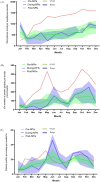The epidemic trend of rhinovirus in children from 2013 to 2023: a large sample study in China
- PMID: 40660247
- PMCID: PMC12261615
- DOI: 10.1186/s13052-025-02069-6
The epidemic trend of rhinovirus in children from 2013 to 2023: a large sample study in China
Abstract
Background: This study described the prevalence trend of human rhinovirus(HRV) in children with acute respiratory infections(ARIs), which can warn people to interfere in advance and prevent the spread of rhinovirus.
Methods: We retrospectively collected the data on sex, age, admission time, discharge diagnosis and HRV reverse transcription polymerase chain reaction (RT-PCR) assay result of inpatients at Children's Hospital of Soochow University from 2010 to 2023.
Results: There are 77,062 patients were enrolled, including 44,564 males (57.8%) and 32,498 females (42.2%). The positive rate of HRV during pre-, during- and post abolition-NPIs periods was 13.1%(5473/41875), 18.5%(3843/20800) and 21.0%(3031/14398), respectively. It was significant that the positive rate of HRV was gradually increasing with time(P<0.05). By multivariate regression analysis HRV prevalence were more common in male than female over all periods(P<0.05). HRV were more common in ≤ 1 year group than other age groups in pre-NPIs period (P<0.05). In during-NPIs and post-NPIs periods, HRV was more likely to occur in the 3-≤6 years groups. The seasonal trend of HRV showed a double peak each year, but the peak of it was advanced by one month in post-NPIs period.
Conclusions: Although the NPIs could not effectively prevent the spread of HRV, it changed the age and seasonal epidemic pattern of HRV in children.
Keywords: Children; Epidemiology; NPIs; Rhinovirus.
© 2025. The Author(s).
Conflict of interest statement
Declarations. Ethics approval and consent to participate: This study adheres to the ethical principles of the Declaration of Helsinki. It was approved by the Ethics Committee of Children’s Hospital of Soochow University (No.2024CS058). For the presented retrospective data, the requirement to obtain informed consent was waived in accordance with the vote of the Ethics Committee. Consent for publication: Not applicable. Conflict of interest: No potential conflicts of interest relevant to this article were reported.
Figures



Similar articles
-
Epidemiology and clinical characteristics of human rhinovirus in hospitalized children and adolescents with acute respiratory infections: a longitudinal study in Shenzhen, China (2019-2024).Virol J. 2025 Aug 14;22(1):280. doi: 10.1186/s12985-025-02901-9. Virol J. 2025. PMID: 40814124 Free PMC article.
-
Dynamics of respiratory virus transmission in children during and after COVID-19 outbreak control in Baiyin, China.BMC Infect Dis. 2025 Jul 7;25(1):901. doi: 10.1186/s12879-025-11285-8. BMC Infect Dis. 2025. PMID: 40624459 Free PMC article.
-
Physical interventions to interrupt or reduce the spread of respiratory viruses.Cochrane Database Syst Rev. 2023 Jan 30;1(1):CD006207. doi: 10.1002/14651858.CD006207.pub6. Cochrane Database Syst Rev. 2023. PMID: 36715243 Free PMC article.
-
Changes in the epidemic patterns of respiratory pathogens of children in guangzhou, China during the COVID-19 pandemic.BMC Infect Dis. 2025 Jul 1;25(1):833. doi: 10.1186/s12879-025-11215-8. BMC Infect Dis. 2025. PMID: 40597730 Free PMC article.
-
The effect of sample site and collection procedure on identification of SARS-CoV-2 infection.Cochrane Database Syst Rev. 2024 Dec 16;12(12):CD014780. doi: 10.1002/14651858.CD014780. Cochrane Database Syst Rev. 2024. PMID: 39679851 Free PMC article.
References
-
- Meissner HC. More on viral bronchiolitis in children. N Engl J Med. 2016;375(12):1200. - PubMed
-
- Fine J, Bray-Aschenbrenner A, Williams H, Buchanan P, Werner J. The resource burden of infections with rhinovirus/enterovirus, influenza, and respiratory syncytial virus in children. Clin Pediatr (Phila). 2019;58(2):177–84. - PubMed
MeSH terms
Grants and funding
LinkOut - more resources
Full Text Sources

